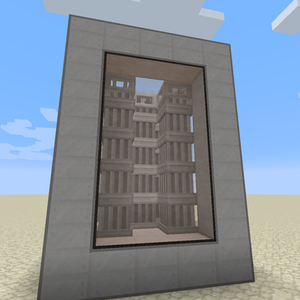Fission Reactor: Difference between revisions
No edit summary |
|||
| Line 16: | Line 16: | ||
** Control rods must not touch each other. The highest control rod density can be achieved by placing them in a checker board patters. | ** Control rods must not touch each other. The highest control rod density can be achieved by placing them in a checker board patters. | ||
Some example control rod setups as seen from the top ( | |||
Some example control rod setups as seen from the top ( is for [[Fission Reactor Casing]] or [[Reactor Glass]], R is for a control rod): | |||
CCCCC CCCCC | CCCCC CCCCC | ||
| Line 23: | Line 24: | ||
CCC C C CR RC | CCC C C CR RC | ||
CCCCC CCCCC | CCCCC CCCCC | ||
A fission reactor requires at least 4 [[Fission Reactor Port]]s: | A fission reactor requires at least 4 [[Fission Reactor Port]]s: | ||
| Line 30: | Line 32: | ||
* One [[Fissile Fuel]] input | * One [[Fissile Fuel]] input | ||
* One waste output | * One waste output | ||
Output ports must be configured to the proper output type by right-clicking them with a [[Configurator]]. | Output ports must be configured to the proper output type by right-clicking them with a [[Configurator]]. | ||
Revision as of 14:28, 22 July 2020

This page is a work in progress! Many essential things are missing.
The Fission Reactor is a multiblock structure that allows for variable input rates of Fissile Fuel. The reactor uses either Sodium or water as a coolant. Power is generated by converting the generated heat into power in an Industrial Turbine. With water cooled reactors, this is done by directly piping steam into an Industrial Turbine. Sodium cooled reactors use a Thermoelectric Boiler as a heat-exchanger to cool down the Superheated sodium and heat up water into Steam.
Contents
Construction
- The structure must be a cuboid of minimum size 3x4x3, up to 18x18x18.
- The edges of the outer shell must be made of Fission Reactor Casing
- The faces of the outer shell can be either Fission Reactor Casing, Reactor Glass, Fission Reactor Port or Fission Reactor Logic Adapter
- The interior of the cube can be either air or fission control rods"
- A control rod is which are a 1x1 block wide column made of 1 to 15 Fission Fuel Assembly and a single Control Assembly at the top
- Control rods must not touch each other. The highest control rod density can be achieved by placing them in a checker board patters.
Some example control rod setups as seen from the top ( is for Fission Reactor Casing or Reactor Glass, R is for a control rod):
CCCCC CCCCC
CCC C C CR RC
CRC CR RC C R C
CCC C C CR RC
CCCCC CCCCC
A fission reactor requires at least 4 Fission Reactor Ports:
- One coolant input
- One coolant output
- One Fissile Fuel input
- One waste output
Output ports must be configured to the proper output type by right-clicking them with a Configurator.
Burn rate
Radiation
As a byproduct of burning Fissile Fuel, fission reactors produce Nuclear Waste which can be converted in either Polonium Pellet or Plutonium Pellet. Both conversion paths produce Spent Nuclear Waste as a byproduct (at a ratio of 10:1), which must be stored in Radioactive Waste Barrels. Nuclear Waste or Spent Nuclear Waste can be piped into a Nuclear Waste Barrel from its top side with a Pressurized Tube.
- Nuclear Waste is radioactive.
- All products and intermediate products of converting Uranium Ore to Fissile Fuel are not radioactive, i.e. safe to handle.
- Intermediate products of recycling Nuclear Waste are radioactive: Polonium, Plutonium and Spent Nuclear Waste.
- Plutonium Pellets and Polonium Pellets are not radioactive.
Radiation can leak into the environment for the following reasons:
- Fission reactor overheating leading to a core meltdown (actually blowing up).
- Fission reactor running with its waste tank full.
- Breaking any block containing radioactive materials. Most notably Pressurized Tubes and Radioactive Waste Barrels, but also any machine (like a Pressurized Reaction Chamber containing radioactive materials. These can still be broken safely if they are somehow drained of their radioactive contents beforehand.
The player can check the storage status of Nuclear Waste Barrels by crouching and right-clicking it with an empty hand. Green radiation particles start to appear as a barrel fills up (these are just a rough visual indicator of a barrel's fill ratio, not actual radiations).
While a barrel containing waste cannot be moved (because they cannot be broken safely in the first place), its contents can be drained from its bottom side with a tube in pull mode and moved to another barrel with a tube network. Once empty, the barrel can be safely broken.
Quantum Entangloporters cannot handle radioactive materials. i.e. it is not possible to make Polonium Pellets with a reactor in the nether or have a reactor in the overworld and store waste in the nether.


